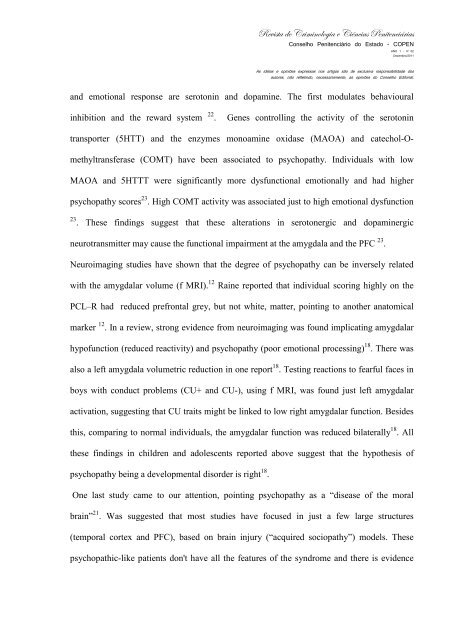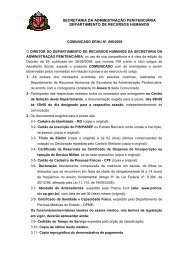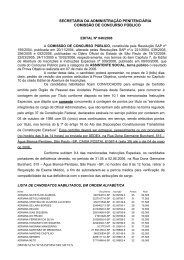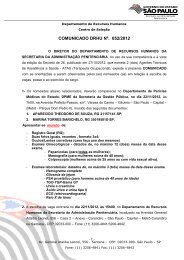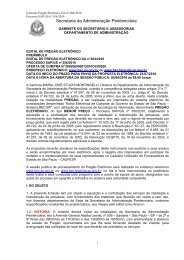exä|áà t wx VÃ|à |ÃÃÃÃz|t x V|£Ãv|tá cxÃ|à xÃv|öÃ|tá - Procrim
exä|áà t wx VÃ|à |ÃÃÃÃz|t x V|£Ãv|tá cxÃ|à xÃv|öÃ|tá - Procrim
exä|áà t wx VÃ|à |ÃÃÃÃz|t x V|£Ãv|tá cxÃ|à xÃv|öÃ|tá - Procrim
Create successful ePaper yourself
Turn your PDF publications into a flip-book with our unique Google optimized e-Paper software.
exä|áàt <strong>wx</strong> VÜ|Å|ÇÉÄÉz|t x V|£Çv|tá cxÇ|àxÇv|öÜ|táConselho Penitenciário do Estado - COPENANO 1 – nº 02Dezembro/2011As idéias e opiniões expressas nos artigos são de exclusiva responsabilidade dosautores, não refletindo, necessariamente, as opiniões do Conselho Editorial.and emotional response are serotonin and dopamine. The first modulates behaviouralinhibition and the reward system 22 .Genes controlling the activity of the serotonintransporter (5HTT) and the enzymes monoamine oxidase (MAOA) and catechol-Omethyltransferase(COMT) have been associated to psychopathy. Individuals with lowMAOA and 5HTTT were significantly more dysfunctional emotionally and had higherpsychopathy scores 23 . High COMT activity was associated just to high emotional dysfunction23 . These findings suggest that these alterations in serotonergic and dopaminergicneurotransmitter may cause the functional impairment at the amygdala and the PFC 23 .Neuroimaging studies have shown that the degree of psychopathy can be inversely relatedwith the amygdalar volume (f MRI). 12 Raine reported that individual scoring highly on thePCL–R had reduced prefrontal grey, but not white, matter, pointing to another anatomicalmarker 12 . In a review, strong evidence from neuroimaging was found implicating amygdalarhypofunction (reduced reactivity) and psychopathy (poor emotional processing) 18 . There wasalso a left amygdala volumetric reduction in one report 18 . Testing reactions to fearful faces inboys with conduct problems (CU+ and CU-), using f MRI, was found just left amygdalaractivation, suggesting that CU traits might be linked to low right amygdalar function. Besidesthis, comparing to normal individuals, the amygdalar function was reduced bilaterally 18 . Allthese findings in children and adolescents reported above suggest that the hypothesis ofpsychopathy being a developmental disorder is right 18 .One last study came to our attention, pointing psychopathy as a “disease of the moralbrain” 21 . Was suggested that most studies have focused in just a few large structures(temporal cortex and PFC), based on brain injury (“acquired sociopathy”) models. Thesepsychopathic-like patients don't have all the features of the syndrome and there is evidence


